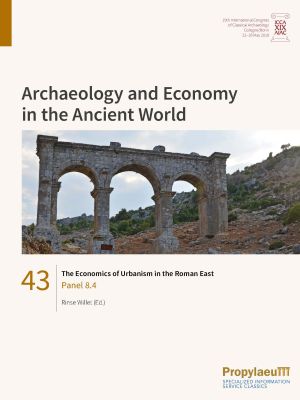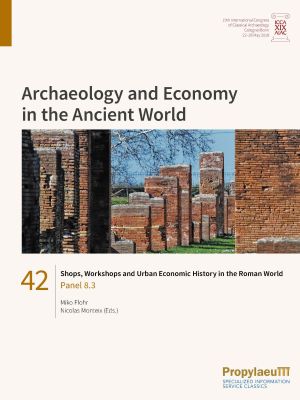Willet, Rinse
The Economics of Urbanism in the Roman East: Panel 8.4
Dieser Band beschäftigt sich mit der Geographie der Städte des östlichen Mittelmeerraumes unter römischer Herrschaft. Die Altertumskunde hat sich intensiv mit römischem Urbanismus auseinandergesetzt, es ist jedoch so, dass viele Studien die antike Stadt als isoliertes historisches Phänomen betrachtet haben oder bestenfalls als Spiegelbild der Verbreitung des Hellenismus oder der Romanitas. Dieser Band versucht, einen Schritt weiterzugehen und die Stadt in sozioökonomischer Hinsicht zu verstehen und dabei die neuesten statistischen Daten für das Phänomen Stadt im römischen Osten zu präsentieren. Sechs Beiträge setzen sich hierbei mit Fragen der räumlichen Verteilung der Städte in der östlichen Reichshälfte auseinander. Ein Beitrag befasst sich als Vergleich mit Aspekten des römischen Urbanismus auf der Iberischen Halbinsel. Beginnend mit einem Überblick über den östlichen Mittelmeerraum als Ganzes, fokussiert sich jeder Beitrag auf eine spezifische Region zur Untersuchung der Faktoren, die das Muster der städtischen Besiedlung und die Variation der Stadtgröße auf (über-)regionaler und lokaler Ebene geprägt haben. Diese Faktoren sind vielfältig und reichen von klimatischen Schwankungen und Möglichkeiten der Konnektivität über Straßen oder Seewege über historische Pfadabhängigkeiten und das jeweilige landwirtschaftliche Potential bis hin zu spezifischen Strategien des römischen Imperialismus.
Shops, Workshops and Urban Economic History in the Roman World: Panel 8.3
Die materiellen Überreste römischer Läden und Werkstätten im urbanen Kontext spielten in der klassischen Archäologie lange Zeit eine marginale Rolle, doch in den vergangenen Jahren erfreuten sie sich einer deutlich gestiegenen wissenschaftlichen Aufmerksamkeit. Beeinflusst durch Debatten über das Wesen der antiken städtischen Wirtschaftsstrukturen begann die Forschung ab den späten 1990er Jahren die archäologischen Beweise für den städtischen Einzelhandel sowie die städtische Produktion mit einer neuen und stärkeren Intensität zu untersuchen.
Seit der Jahrtausendwende haben Wissenschaftlerinnen und Wissenschaftler zunehmend damit begonnen, die Gestaltung von Läden und Werkstätten in Bezug auf gewinnorientierte Investitionsstrategien zu untersuchen und die Wirtschaftsgeschichte städtischer Gewerbelandschaften zu erforschen. Dieser Band diskutiert die Art und Weise, in der die Untersuchung von urbanen Läden und Werkstätten unsere Konzeptualisierung der städtischen Wirtschaftsgeschichte in der römischen Welt in Frage gestellt hat, und er untersucht mögliche Wege, um unser Verständnis des sich wandelnden Charakters des römischen urbanen Handels weiter zu vertiefen und räumliche sowie zeitliche Distanzen zwischen lokalen Zeugnissen zu überbrücken.








